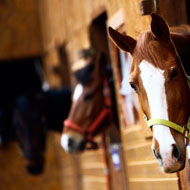Latest equine disease report released

There were 72 UK cases of atypical myopathy between January 1 and November 12 this year.
Fourteen cases of equine influenza virus (EI) have been confirmed in the UK since the start of October 2014, according to the latest equine disease surveillance report.
The report, which is published by Defra, the Animal Health Trust and the British Equine Veterinary Association, provides a snapshot of equine disease in the UK and globally.
Of the fourteen outbreaks of EI since October, one was due to a vaccine failure. All affected horses had been recently imported from Ireland or local horse sales.
From the start of this year up until November 12, there were 72 clinical cases of atypical myopathy in the UK.
Two cases of equine herpes virus-1 (EHV-1) were confirmed in October, in a four-year-old donkey in Devon and a seven-year-old thoroughbred gelding in Essex.
Globally, reported statistics include:
- Eight new cases of equine infectious anaemia (EIA) were reported in Italy between September 24 and November 3.
- In October, there was an outbreak of EI at a riding school in Aine, France. Two ponies that had been recently imported from Ireland tested positive for the virus and 22 others at the school showed clinical signs. A further case was confirmed at a riding school in Seine-et-Marne.
- Also in October, there were two cases of EHV-1 in Manche, France, and a further case in Calvados.
- As of November 6, the number of cases of equine eastern encephalomyelitis in the US rose to 117. The disease has been diagnosed in 15 states.
For the full report, visit the BEVA's website: http://www.beva.org.uk/news-and-events/news/view/682



 BSAVA is to partner with BVA Live (11-12 June 2026) to champion clinical research.
BSAVA is to partner with BVA Live (11-12 June 2026) to champion clinical research.